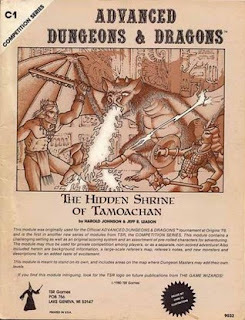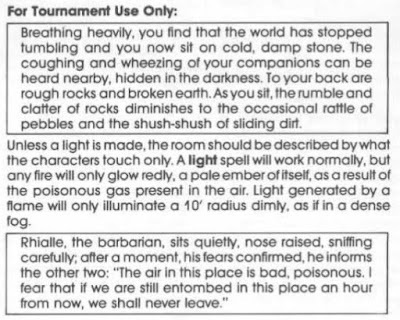Patient Zero
 With the publication of the Dungeon Masters Guide in August 1979, Gary Gygax's Advanced Dungeons & Dragons project was essentially complete (though we would nevertheless see the publication of not one but two more hardback AD&D volumes over the next couple of years). Consequently, 1980 was the start of a period in TSR's history when the company shifted its focus to supporting Dungeons & Dragons in both its Basic and Advanced formats. One of the most significant ways it did so was through the publication of numerous adventure modules. Indeed, by dint of the sheer number of them released, adventure modules would effectively become TSR's signature products.
With the publication of the Dungeon Masters Guide in August 1979, Gary Gygax's Advanced Dungeons & Dragons project was essentially complete (though we would nevertheless see the publication of not one but two more hardback AD&D volumes over the next couple of years). Consequently, 1980 was the start of a period in TSR's history when the company shifted its focus to supporting Dungeons & Dragons in both its Basic and Advanced formats. One of the most significant ways it did so was through the publication of numerous adventure modules. Indeed, by dint of the sheer number of them released, adventure modules would effectively become TSR's signature products.Among the modules published in 1980 was Harold Johnson and Jeff R. Leason's The Hidden Shrine of Tamoachan . Designated module C1 (for "Competition"), the module is highly regarded for both its exotic Mesoamerican-inspired flavor and the cleverness of its many tricks and traps. Johnson and Leason originally wrote the module for use at the Official Advanced Dungeons & Dragons tournament at Origins '79, hence its "competition" designation. For that reason, it includes an extensive scoring system for tournament use, as well as a strict real time limit of 2 hours to complete.
In addition, the module includes the following in its "Notes for the Dungeon Master:"
It will be noticed that encounter descriptions are divided into boxed and open sections. The boxed sections contain information which should be read to the players; the rest is information for the DM. In most cases, the same players' description is used no matter which direction the party enters from, but 2 cases require that special descriptions be read depending on the direction from which the party approaches the encounter area. The DM should be aware of this and be careful to read the proper players' description.
The players' descriptions are provided because many of the encounters require specific actions on the part of the group. Hints of what may be done are given in this text and the DM should only provide vague information if questioned. Plauers will be to see the exact contents of a room unless noted.
Unless I am mistaken – and please correct me if I am – this is the very first published appearance of the dreaded boxed text in any TSR module.
Within the very specific context of a module written for tournament use, particularly one with a strict real time limit, the inclusion of boxed, descriptive text makes a great deal of sense. After all, it would be unfair to the players participating in the tournament if some referees were more loquacious than others in their descriptions, time being a valuable resource. Fairness would likewise demand that each group of players be given the exact same descriptions of the dungeon's rooms. Once again, I say this makes perfect sense within this very specific context.
The trouble, I think, arises when TSR, in an effort to publish a large number of modules over a short period of time, turned ever more often to those originally created for tournaments. In this way, the style and presentation of tournament modules, including read-aloud boxed text, came to be seen not as unique features of tournament modules as such but simply as features of D&D modules in general. This is especially notable in modules published for the Basic and Expert versions of D&D, but, over time, it comes to be standard even in AD&D modules.
The lasting impact of the D&D tournament scene cannot be overstated.

James Maliszewski's Blog
- James Maliszewski's profile
- 3 followers



